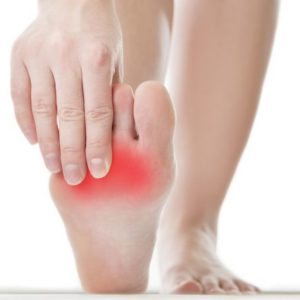Morton’s Neuroma: The pebble at the bottom of your foot
October 5, 2017
 Does it feel like you’ve been walking around on an uncomfortable small stone beneath your foot for some time now? Have you been feeling pain at the forefoot that seems unusual? And that while Google tells you this pain should be located beneath the big toe joint or at one of the other toes along the ball of your foot, you’re actually feeling it up from there, through the long bones of the foot? Perhaps around your 3rd and 4th long toe bones? And maybe instead of the usual pain, redness and swelling, the pain and discomfort comes with a twinge every so often that may tingle or feel numb?
If this sounds familiar then you, my friend, may have a Morton’s Neuroma.
What is a Morton’s Neuroma?
A neuroma describes a thickened or inflamed nerve in a space between the toes (interdigital space). Just like rubbing and irritating a muscle, the same can happen to your nerves! It often occurs between the 3rd and 4th toes, though can occur in between the 2nd and 3rd toes , and may be a palpable round mass.
The cause of a neuroma is often repetitive compression of the nerve which may occur from:
Does it feel like you’ve been walking around on an uncomfortable small stone beneath your foot for some time now? Have you been feeling pain at the forefoot that seems unusual? And that while Google tells you this pain should be located beneath the big toe joint or at one of the other toes along the ball of your foot, you’re actually feeling it up from there, through the long bones of the foot? Perhaps around your 3rd and 4th long toe bones? And maybe instead of the usual pain, redness and swelling, the pain and discomfort comes with a twinge every so often that may tingle or feel numb?
If this sounds familiar then you, my friend, may have a Morton’s Neuroma.
What is a Morton’s Neuroma?
A neuroma describes a thickened or inflamed nerve in a space between the toes (interdigital space). Just like rubbing and irritating a muscle, the same can happen to your nerves! It often occurs between the 3rd and 4th toes, though can occur in between the 2nd and 3rd toes , and may be a palpable round mass.
The cause of a neuroma is often repetitive compression of the nerve which may occur from:
- Faulty foot biomechanics that overload and increase pressure to the area of the nerve
- Ill-fitting footwear that squeezes the forefoot such as high heels
- Trauma/Injury
- A sharp or burning pain at the ball of the foot
- Numbness/tingling at the foot that can spread to the toes
- Feeling a ‘click’ when walking or moving the metatarsal bones
- Assess the foot and neuroma (if present)
- Examine the biomechanics of your feet and legs that may have contributed to the development and progression of the neuroma
- Identify any other causes or contributing factors
- Address contributing factors to relieve current pain and minimise the risk of growth in size of the neuroma and future recurrence
- Look after you and your foot health!
